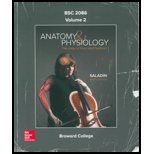
Introduction:
The reproductive organs are associated with the production of reproductive units called gametes. The purpose of these units is to facilitate the process of zygote formation (fertilization). The secondary reproductive organs provide support and protection.
Answer to Problem 1TYR
Correct answer:
The correct answer is option (a) − the clitoris.
Explanation of Solution
Explanation/justification for the correct answer:
Option (a) − this region is the most sensitive part of the female reproductive system and it lies within the vulva. Both this and the penis are highly sensitive and they possess glans (a specialized rounded part in the terminal portion of both the organs). Thus, the clitoris refers to the highly erectile structure of the female reproductive system which is analogous to the penis in the male reproductive system.
An Explanation for incorrect answer:
Option (b) − vagina: This part connects the external parts of the genital tract with the inner regions. This area also serves as the entry point for male gametes during sexual intercourse. However, these are not similar to the penis which is the primary erectile structure of the male reproductive system. Hence, this is an incorrect answer.
Option (c) − vestibular bulbs: These are erectile tissues that are associated with the clitoris. However, these are not analogous to the penis. Hence, this is an incorrect answer.
Option (d) − labia minora: These are the structures located between the clitoris (of the vulva) and the vagina. However, these are not analogous to the penis. Hence, this is an incorrect answer.
Option (e) − prepuce: This is a cutaneous cum mucus covering around the clitoris. This structure is not analogous to the male erectile reproductive organ. Hence, this is an incorrect answer.
Want to see more full solutions like this?
Chapter 28 Solutions
ANATOMY+PHYSIOLOGY,VOL.2 >CUSTOM<
- please fill in the empty sports, thank you!arrow_forwardIn one paragraph show how atoms and they're structure are related to the structure of dna and proteins. Talk about what atoms are. what they're made of, why chemical bonding is important to DNA?arrow_forwardWhat are the structure and properties of atoms and chemical bonds (especially how they relate to DNA and proteins).arrow_forward
- The Sentinel Cell: Nature’s Answer to Cancer?arrow_forwardMolecular Biology Question You are working to characterize a novel protein in mice. Analysis shows that high levels of the primary transcript that codes for this protein are found in tissue from the brain, muscle, liver, and pancreas. However, an antibody that recognizes the C-terminal portion of the protein indicates that the protein is present in brain, muscle, and liver, but not in the pancreas. What is the most likely explanation for this result?arrow_forwardMolecular Biology Explain/discuss how “slow stop” and “quick/fast stop” mutants wereused to identify different protein involved in DNA replication in E. coli.arrow_forward
- Molecular Biology Question A gene that codes for a protein was removed from a eukaryotic cell and inserted into a prokaryotic cell. Although the gene was successfully transcribed and translated, it produced a different protein than it produced in the eukaryotic cell. What is the most likely explanation?arrow_forwardMolecular Biology LIST three characteristics of origins of replicationarrow_forwardMolecular Biology Question Please help. Thank you For E coli DNA polymerase III, give the structure and function of the b-clamp sub-complex. Describe how the structure of this sub-complex is important for it’s function.arrow_forward
 Biology 2eBiologyISBN:9781947172517Author:Matthew Douglas, Jung Choi, Mary Ann ClarkPublisher:OpenStax
Biology 2eBiologyISBN:9781947172517Author:Matthew Douglas, Jung Choi, Mary Ann ClarkPublisher:OpenStax Human Physiology: From Cells to Systems (MindTap ...BiologyISBN:9781285866932Author:Lauralee SherwoodPublisher:Cengage Learning
Human Physiology: From Cells to Systems (MindTap ...BiologyISBN:9781285866932Author:Lauralee SherwoodPublisher:Cengage Learning Comprehensive Medical Assisting: Administrative a...NursingISBN:9781305964792Author:Wilburta Q. Lindh, Carol D. Tamparo, Barbara M. Dahl, Julie Morris, Cindy CorreaPublisher:Cengage Learning
Comprehensive Medical Assisting: Administrative a...NursingISBN:9781305964792Author:Wilburta Q. Lindh, Carol D. Tamparo, Barbara M. Dahl, Julie Morris, Cindy CorreaPublisher:Cengage Learning Fundamentals of Sectional Anatomy: An Imaging App...BiologyISBN:9781133960867Author:Denise L. LazoPublisher:Cengage Learning
Fundamentals of Sectional Anatomy: An Imaging App...BiologyISBN:9781133960867Author:Denise L. LazoPublisher:Cengage Learning





